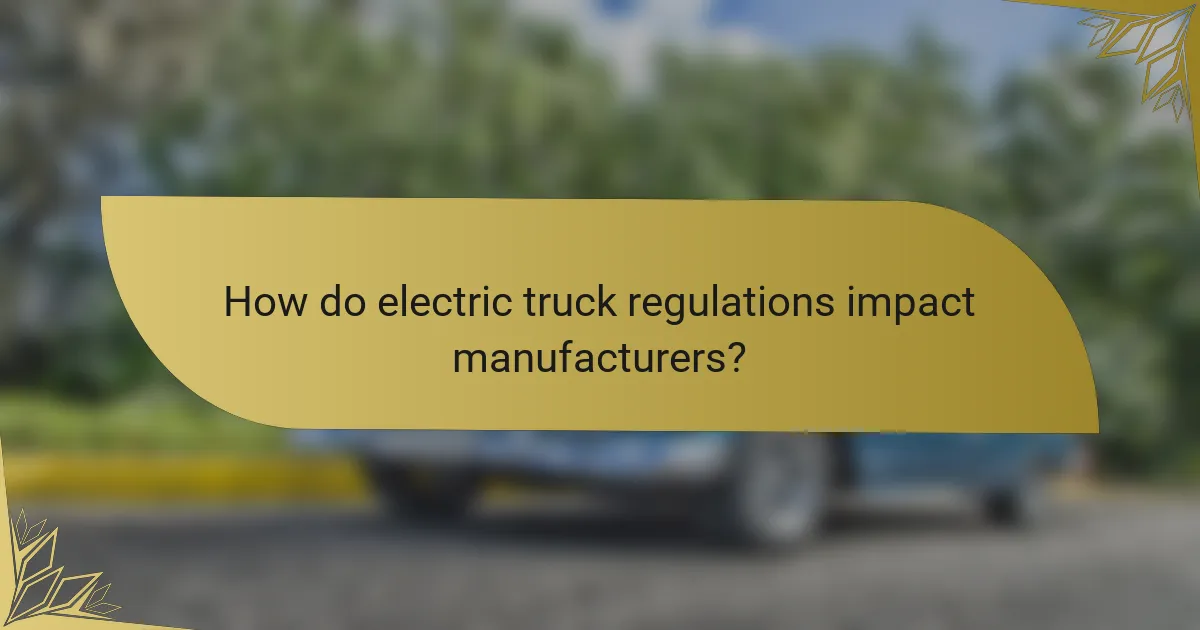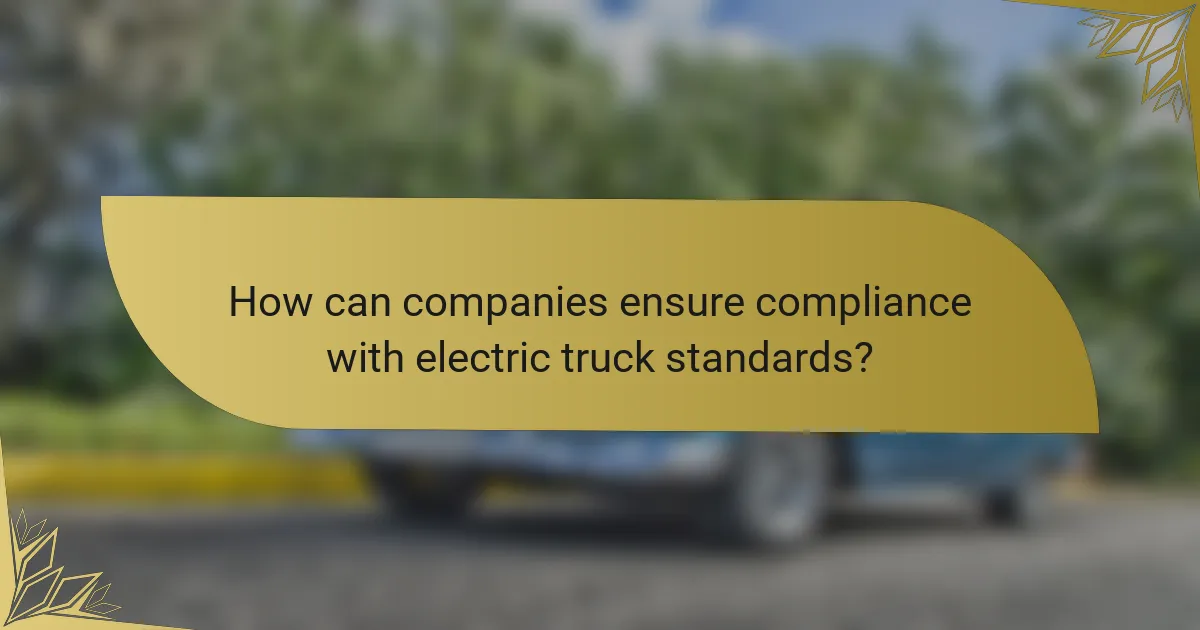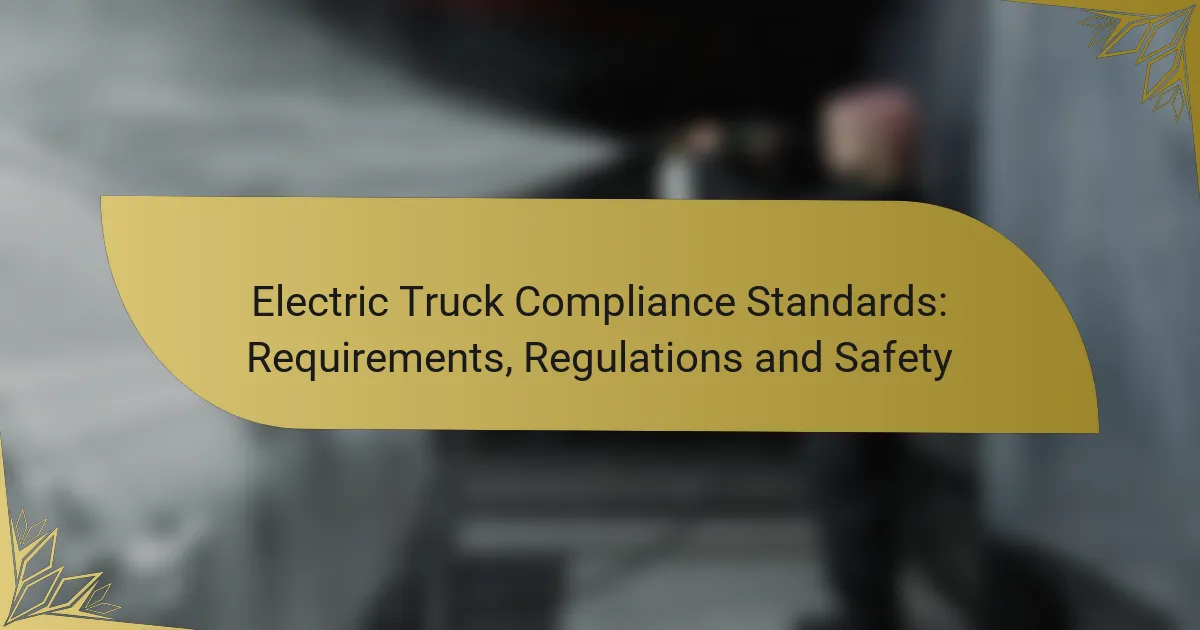Electric trucks in the United States are subject to a range of compliance standards designed to ensure safety, environmental protection, and operational efficiency. These regulations, established by federal and state agencies, encompass critical aspects such as vehicle safety, emissions, and energy consumption, significantly impacting manufacturers’ design and engineering processes.

What are the compliance standards for electric trucks in the United States?
Electric trucks in the United States must adhere to various compliance standards that ensure safety, environmental protection, and operational efficiency. These standards are set by federal and state agencies and cover aspects such as vehicle safety, emissions, and energy consumption.
Federal Motor Vehicle Safety Standards (FMVSS)
The FMVSS are a set of regulations established by the National Highway Traffic Safety Administration (NHTSA) that apply to all motor vehicles, including electric trucks. These standards cover critical safety aspects such as crashworthiness, braking performance, and vehicle lighting.
Manufacturers must ensure their electric trucks meet these standards before they can be sold in the U.S. Compliance is typically verified through testing and certification processes. Failure to meet FMVSS can result in recalls and penalties.
Environmental Protection Agency (EPA) regulations
The EPA sets regulations that electric trucks must follow to minimize their environmental impact. These regulations focus on emissions, energy efficiency, and the use of environmentally friendly materials. Electric trucks are generally exempt from certain emissions standards applicable to traditional combustion engine vehicles.
Manufacturers must provide data on energy consumption and emissions during testing to demonstrate compliance. The EPA also offers incentives for electric vehicles that meet specific efficiency criteria, which can benefit manufacturers and consumers alike.
California Air Resources Board (CARB) requirements
California has some of the strictest vehicle emissions regulations in the U.S., enforced by the CARB. Electric trucks sold in California must comply with these additional requirements, which include zero-emission vehicle (ZEV) mandates and specific performance standards.
Manufacturers must track and report emissions data, and they may need to participate in incentive programs that encourage the adoption of electric vehicles. Compliance with CARB standards can enhance marketability in California, but it also requires more rigorous testing and documentation.

How do electric truck regulations impact manufacturers?
Electric truck regulations significantly influence manufacturers by dictating design, engineering, and operational standards. Compliance with these regulations ensures vehicles meet safety, environmental, and performance benchmarks, which can affect production timelines and costs.
Design and engineering modifications
Manufacturers must adapt their designs and engineering processes to comply with electric truck regulations. This often involves integrating advanced battery systems, electric drivetrains, and safety features that meet specific regulatory requirements. For example, manufacturers may need to redesign chassis to accommodate heavier battery packs while ensuring structural integrity.
Additionally, compliance may require implementing new technologies such as regenerative braking systems and enhanced thermal management solutions. These modifications can lead to increased complexity in the design phase, necessitating collaboration with engineering teams to ensure all aspects meet regulatory standards.
Cost implications for compliance
Compliance with electric truck regulations can lead to significant cost implications for manufacturers. Initial investments in research and development, new materials, and advanced technologies can be substantial, often reaching millions of dollars. However, these costs can vary widely depending on the scale of production and the specific regulations in place.
Manufacturers should also consider ongoing costs related to compliance, such as regular testing and certification of vehicles. Budgeting for these expenses is crucial, as failure to comply can result in fines or the inability to sell vehicles in certain markets. A proactive approach to understanding and integrating compliance costs can help manufacturers maintain competitive pricing while meeting regulatory demands.

What safety requirements must electric trucks meet?
Electric trucks must adhere to various safety requirements to ensure their safe operation on public roads. These include standards for battery safety, crashworthiness, and overall vehicle stability, which are critical for protecting both drivers and pedestrians.
Battery safety standards
Battery safety standards for electric trucks focus on preventing hazards such as fires or chemical leaks. Manufacturers must comply with regulations that dictate the design, testing, and performance of batteries, including thermal stability and resistance to mechanical stress.
Common standards include the UN 38.3 for transport safety and IEC 62133 for battery performance. These regulations require rigorous testing, such as overcharging and short-circuit tests, to ensure batteries can withstand extreme conditions without failure.
Crashworthiness and stability tests
Crashworthiness and stability tests evaluate how well electric trucks can protect occupants during collisions. These tests assess the structural integrity of the vehicle and its ability to absorb impact energy, which is crucial for minimizing injuries in accidents.
Electric trucks must undergo standardized crash tests, including frontal, side, and rollover tests, to meet safety ratings. Manufacturers often aim for high ratings in these tests to enhance consumer confidence and comply with regulatory requirements.

What are the regional compliance differences for electric trucks?
Regional compliance differences for electric trucks primarily stem from varying state and city regulations that dictate emissions standards, safety protocols, and operational requirements. Understanding these differences is crucial for manufacturers and operators to ensure adherence and avoid penalties.
State-specific regulations in California
California has some of the most stringent regulations for electric trucks in the United States. The California Air Resources Board (CARB) mandates specific emissions standards and requires manufacturers to meet the Zero Emission Vehicle (ZEV) program criteria. This includes a gradual increase in the percentage of zero-emission trucks sold in the state.
Operators must also comply with the state’s Advanced Clean Trucks (ACT) regulation, which aims to reduce greenhouse gas emissions. This regulation requires fleets to transition to electric trucks over time, with specific targets set for different vehicle classes.
Variations in New York City compliance
New York City has its own set of compliance requirements for electric trucks, focusing on both emissions and operational safety. The city enforces local laws that mandate the use of electric vehicles for certain types of deliveries, particularly in densely populated areas. This includes incentives for businesses that adopt electric trucks to reduce air pollution.
Additionally, NYC’s Department of Transportation outlines specific safety regulations for electric trucks, including requirements for visibility, noise levels, and pedestrian safety features. Operators must ensure their vehicles meet these standards to operate legally within the city.

How can companies ensure compliance with electric truck standards?
Companies can ensure compliance with electric truck standards by implementing systematic audits, collaborating with experts, and staying updated on regulations. These steps help maintain safety, efficiency, and adherence to legal requirements in the evolving electric vehicle landscape.
Regular audits and inspections
Conducting regular audits and inspections is crucial for maintaining compliance with electric truck standards. These evaluations should assess vehicle performance, safety features, and adherence to environmental regulations. Companies should schedule these audits at least annually, or more frequently if significant changes occur in operations or regulations.
During audits, focus on key areas such as battery management systems, charging infrastructure, and emissions controls. Document findings and track improvements to ensure ongoing compliance and address any issues promptly.
Collaboration with compliance consultants
Engaging compliance consultants can provide valuable insights into navigating the complex landscape of electric truck regulations. These experts can help identify gaps in compliance, recommend best practices, and ensure that companies meet local and national standards effectively.
When selecting a consultant, consider their experience with electric vehicles and familiarity with specific regulations in your region. Establish clear communication and set measurable goals to maximize the benefits of this collaboration.

What are the penalties for non-compliance with electric truck regulations?
Penalties for non-compliance with electric truck regulations can include substantial fines, legal actions, and operational restrictions. These consequences vary by jurisdiction and can significantly impact a company’s financial health and reputation.
Fines and legal repercussions
Fines for non-compliance can range from hundreds to thousands of dollars, depending on the severity of the violation and local regulations. In some regions, repeated offenses may lead to increased penalties or even criminal charges against responsible parties.
Legal repercussions may include lawsuits from affected parties or regulatory bodies. Companies could face additional costs related to legal defense and potential settlements, which can strain financial resources.
Impact on business operations
Non-compliance can disrupt business operations by leading to vehicle impoundment, operational shutdowns, or increased scrutiny from regulatory agencies. This can result in lost revenue and decreased customer trust.
Companies may also need to invest in compliance measures, such as training programs or equipment upgrades, to avoid future violations. This can divert funds from other critical areas of the business, impacting overall growth and sustainability.

What emerging trends are shaping electric truck compliance?
Emerging trends in electric truck compliance are primarily driven by advancements in technology, regulatory changes, and evolving safety standards. These trends focus on enhancing vehicle performance, reducing emissions, and ensuring safety in operations.
Advancements in battery technology
Battery technology is a crucial factor in electric truck compliance, as it directly impacts range, efficiency, and overall performance. Innovations such as solid-state batteries and improved lithium-ion technologies are increasing energy density and reducing charging times, making electric trucks more viable for long-haul applications.
For instance, modern electric trucks can achieve ranges of 300 to 500 kilometers on a single charge, which is becoming competitive with traditional diesel trucks. However, companies must consider the trade-offs between battery size, weight, and cost when designing their vehicles.
To stay compliant with emerging regulations, manufacturers should prioritize battery safety standards and recycling protocols. Regular assessments of battery performance and adherence to guidelines from organizations like the International Electrotechnical Commission (IEC) can help mitigate risks and enhance sustainability.
